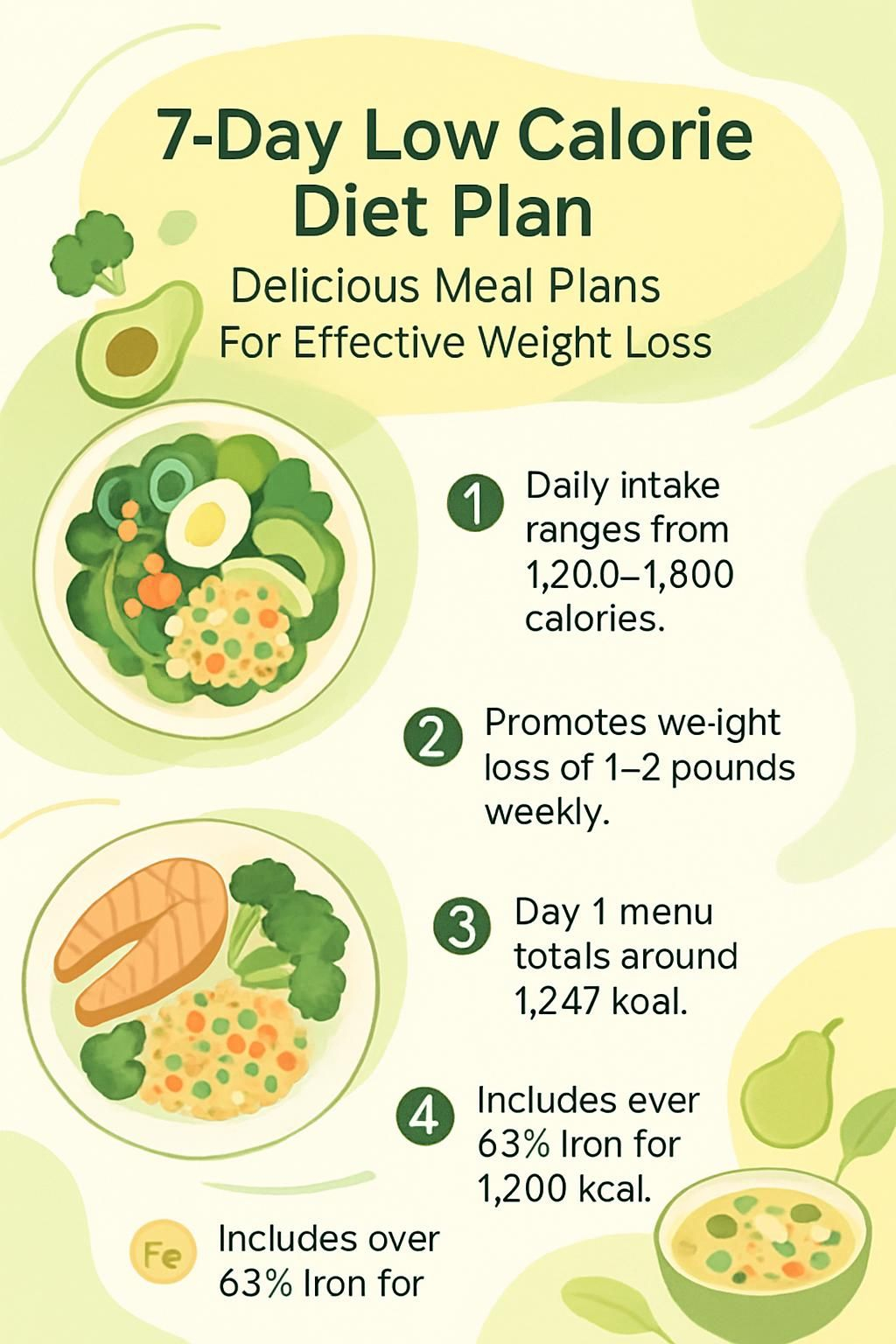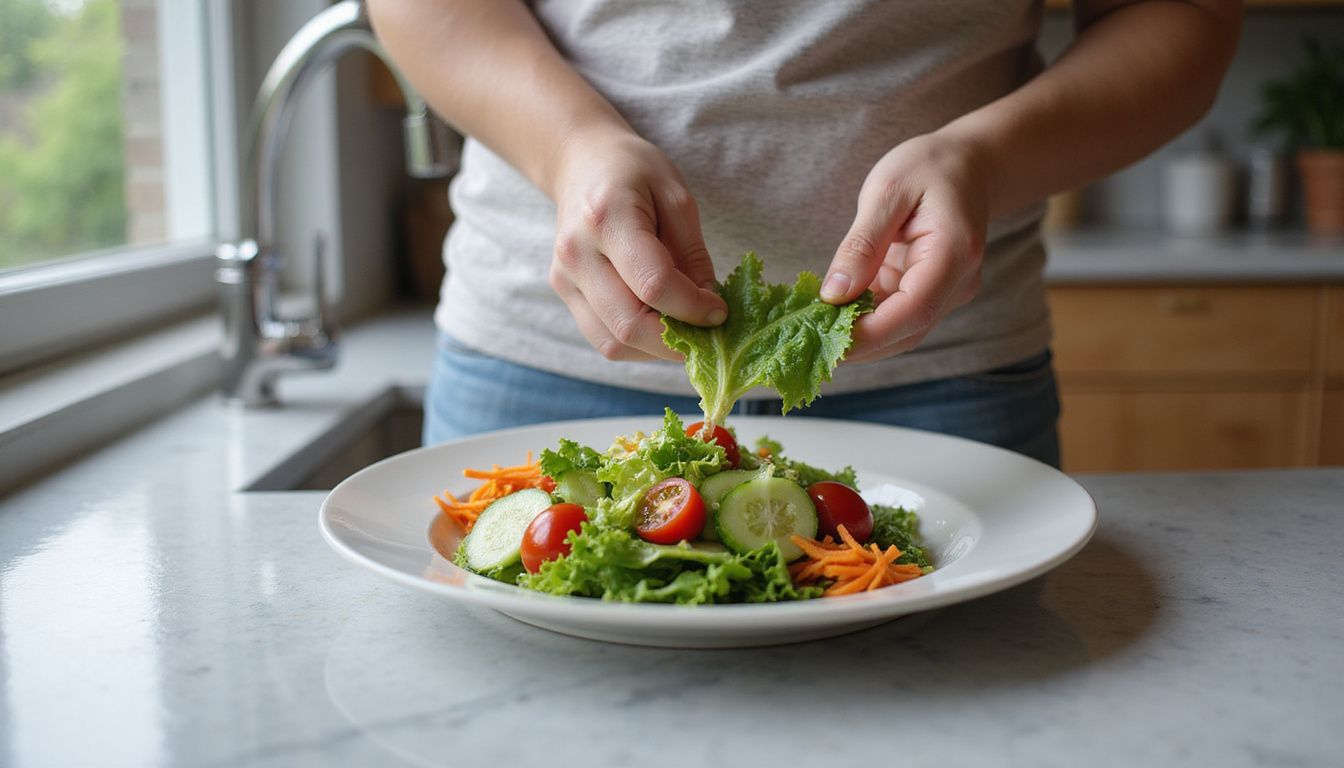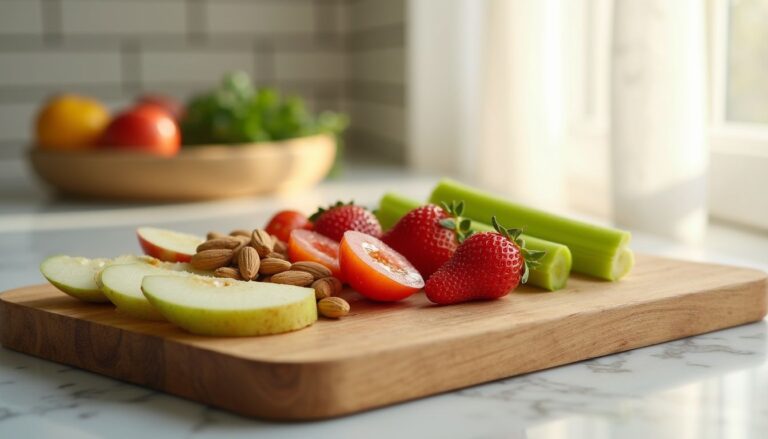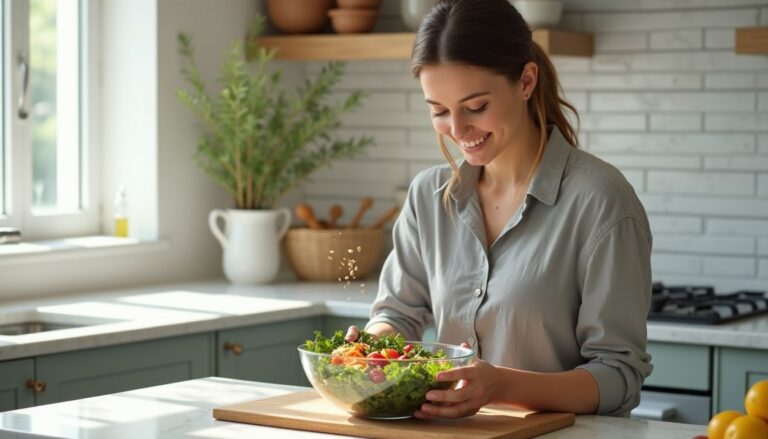7-Day Low Calorie Diet Plan: Delicious Meal Plans For Effective Weight Loss
Our Nutrition Assistant AI Suite will transform your body. You will lose fat, get toned, and build muscle. Gain confidence and optimal health.
You might feel stuck with weight loss or unsure how many calories to eat. A low-calorie meal plan can help you lose about 1 to 2 pounds per week by creating a steady calorie deficit with nourishing foods.
This article gives you a simple 7-day menu with balanced breakfast, lunch, and dinner ideas. Use it to build better habits, reduce guesswork, and make progress with less stress.
Key Takeaways
- A 7-day low-calorie diet plan usually falls between 1,200 and 1,800 calories per day, which can support losing about 1 to 2 pounds weekly, based on NHLBI guidance.
- Meals center on lean protein, fiber-rich vegetables, whole grains like brown rice or quinoa, and healthy fats, while limiting added sugar and highly processed foods.
- Portion control matters. Tracking with a food diary or app helps you stay on target, for example Day 1 totals around 1,247 kcal with about 34 grams of fat.
- Balanced menus aim to cover most vitamins and minerals. If nutrients fall short at lower calories, plan a smart snack to fill the gap using the Dietary Reference Intakes.
- Research links this approach with better energy and lower risk of chronic disease when paired with regular meal prep and consistent activity.

What Is a Low-Calorie Diet and How Does It Work?

A low-calorie diet limits your daily calorie intake to support weight loss. Eating fewer calories than you burn creates a calorie deficit that can lead to fat loss while protecting health.
What is a low-calorie diet and its purpose?
A low-calorie diet sets a daily calorie range, often 1,200 to 1,800, based on your age, sex, activity, and health goals. The National Heart, Lung, and Blood Institute (NHLBI) describes this as a structured way to reduce energy intake and promote weight control with proper nutrition.
People use this eating plan to manage weight and, in some cases, support treatment for issues like high blood pressure. Working with a dietitian helps you build meals with protein and fiber so you feel full while staying within your calorie goals. Choose whole grains, lean proteins like chicken or tofu, colorful vegetables, and healthy fats from nuts or seeds. Limit foods high in added sugar and saturated fat.
Calorie restriction can guide smarter food choices and support long-term weight control.
How does a low-calorie diet help with weight loss?
Reducing daily calories creates an energy gap, so your body uses stored fat for fuel. A 1,200-calorie plan often averages about 1,247 kcal per day with moderate fat, a small share from saturated fat, and a focus on nutrient-dense foods.
Lean proteins and high-fiber vegetables help you stay full and avoid overeating. Spacing meals and planned snacks can curb hunger and improve consistency. Cutting sugary drinks and fast food reduces hidden calories that slow progress. Measuring portions or logging meals increases accuracy and makes your results more predictable.
If late-night cravings are a problem, shrinking portions at dinner and adding a high-protein snack earlier in the evening can help.
Key Principles of a 7-Day Low-Calorie Diet Plan
A 7-day low-calorie diet plan focuses on practical choices that fit your life. You can enjoy flavorful meals, meet your calorie goal, and still feel satisfied.
What are the calorie intake guidelines?
Most low-calorie plans sit between 1,200 and 1,800 calories per day. You might choose 1,200, 1,300, 1,400, 1,500, or 1,800 calories depending on your size, activity, and timeline. One NHLBI example for 1,200 calories splits energy across breakfast, lunch, dinner, and a small snack for a daily total near 1,247 kcal.
Portion control prevents “calorie creep.” Adjust vegetables or lean protein as needed for satiety without overshooting your limit. Aim for at least 32 ounces of water daily to support energy and digestion. Set a clear target, then build your menu around it.
How to ensure balanced nutrition?
Include several food groups at every meal. Combine vegetables, fruit, whole grains like oats or brown rice, lean proteins such as poultry, fish, eggs, or beans, and healthy fats such as olive oil or almond butter. Choose low-fat or fat-free dairy if you use dairy.
A 1,200-calorie plan may reach strong coverage for many vitamins and minerals, but some nutrients, like iron or zinc, can be tight. If you fall short, add a small snack such as nuts, seeds, or a bean salad while staying within your daily calories. High-fiber foods like berries or vegetable soup improve fullness and digestive health.
A plate with fiber-rich vegetables and lean protein tends to be both filling and nutritious.
Why is portion control important?
Measuring portions helps you stay within your calorie budget and maintain steady progress. Energy-dense foods like nuts, avocado, or mayo are healthy, yet easy to overeat. Keep servings modest, for example 2 tablespoons of nut butter or about a quarter cup of nuts.
Set standard sizes for staples, such as 3 to 4 ounces of protein, 1 cup of vegetables, and a measured amount of grains. Pre-portion snacks so you are not grabbing handfuls later. Spacing meals and prepping ahead reduces impulse eating and keeps your plan on track.
Mastering portions builds lasting habits that support consistent weight loss.
What Are the Benefits of a Low-Calorie Diet?
A low-calorie diet can improve energy, help you reach a healthy weight, and lower risk factors for chronic disease. It also encourages smarter eating patterns that are easier to maintain.
How does it promote sustainable weight loss?
Balanced meals with protein, fiber, and measured carbs steady your appetite all day. Protein from chicken or tofu supports muscle, and fiber from vegetables slows digestion so you feel full longer.
Portion control trains you to eat the right amount for your body. Weekly meal prep reduces last-minute choices that often lead to high-calorie convenience food. Mixing animal and plant proteins keeps menus interesting and supports adherence past the first week.
Planning ahead can help you skip late-night snacking and stick with your goals.
In what ways does it improve overall health?
Filling your plate with vegetables, fruit, lean meats, legumes, and whole grains increases vitamins, minerals, and fiber. A low-calorie pattern often reduces saturated fat intake, which supports heart health and healthy cholesterol levels.
Limiting heavily processed foods and added sugars helps keep blood sugar steady. Gentle cooking methods like baking, grilling, or steaming add flavor without extra fat. As excess weight drops, risks for conditions such as heart disease and type 2 diabetes may fall as well.
Drinking at least 32 ounces of water daily supports hydration and metabolism. Many people also notice better energy during workouts after switching to fresh, home-cooked meals.
How does it boost energy levels?
Spacing meals and snacks helps keep energy stable. Whole grains provide complex carbs that release energy slowly. Lean protein supports steady blood sugar and reduces mid-afternoon slumps.
Healthy fats from olive oil or nut butter add satisfaction without spikes and crashes. Simple snacks like popcorn or fruit bridge the gap between meals. On a 1,200-calorie day, many plans average roughly 58 percent of calories from carbs and at least 19 percent from protein, which supports steady fuel for daily tasks.
Sample 7-Day Low-Calorie Diet Plan
This 7-day meal plan offers varied, approachable recipes with both plant and animal proteins. Scan each day, then pick options that match your tastes and schedule.
Day 1:
Day 1 starts with familiar foods and clear portions that make tracking simple.
- Breakfast: 3/4 cup bran flakes, one banana, and one cup fat-free milk. Add a small sprinkle of peanuts if you want healthy fats.
- Lunch: Mini whole wheat pita with 3 ounces turkey breast, half a roasted pepper, 1 teaspoon mayonnaise, mustard, lettuce, and a mozzarella string cheese. Two kiwis on the side.
- Alternate lunch: Veggie niçoise pita at about 290 calories per serving, rich in fiber for fullness.
- Dinner: Four ounces of flounder for lean protein.
- Sides: Couscous with steamed broccoli, plus a single-serve ice cream for a controlled treat.
- Daily total: About 1,247 kcal with around 34 grams fat and roughly 7 percent saturated fat.
- Drink at least 32 ounces of water. Use salsa or spices for flavor instead of heavy sauces.
- Keep portions consistent across proteins, grains, fruit, and vegetables.
- Adding extra vegetables can boost fullness while keeping calories in check.
Understanding why each choice works will help you repeat success all week.
What to eat for breakfast? Overnight oats with almond milk and berries
Combine 1/2 cup quick oats with unsweetened almond milk. Stir in 1/2 cup mixed berries, 1 teaspoon honey, and a pinch of cinnamon. Let it sit in the fridge overnight.
For variety, swap in plain Greek yogurt for extra protein or add a spoonful of bran flakes for crunch. A serving stays under 400 calories and delivers fiber, slow carbs, and antioxidants. High-fiber breakfasts help with fullness and steady energy release^1^.
Berries bring vitamin C and color. Preparing several jars at once gives you grab-and-go breakfasts on busy mornings.
…
^1 Institute of Medicine (US) Panel on Macronutrients, “Dietary Reference Intakes: Energy, Carbohydrate, Fiber…” National Academies Press (2005).
What to eat for lunch? Grilled chicken salad with olive oil dressing
Build a salad with 4 ounces skinless grilled chicken, leafy greens, chopped celery, and 1 tablespoon slivered almonds. Add 1/4 cup red grapes for gentle sweetness. Blend a tablespoon each of mayonnaise and Greek yogurt for creaminess, then finish with a light olive oil dressing.
Serve with one slice of multigrain toast. Expect 300 to 400 calories, strong protein, and satisfying fats. Olive oil provides monounsaturated fats linked to heart benefits. For plant-forward days, use chickpeas or feta as your protein.
This lunch focuses on slow-digesting nutrients, which may prevent afternoon dips.
What to eat for dinner? Baked salmon with steamed broccoli and quinoa
Bake 4 ounces of salmon and pair it with 1 cup steamed broccoli and 1/2 cup cooked quinoa. You will get lean protein, fiber, vitamin C, and iron with about 350 to 500 calories depending on portions.
Roasting and steaming keep flavor high and extra fat low. Swap salmon for flounder or shrimp if you want variety. If dessert fits your day, enjoy a single-serve ice cream once this week without exceeding your total calories. If you have special dietary needs, check with your clinician first.
Day 2:
Day 2 keeps flavors bright while balancing plant and animal proteins to support fullness.
- Breakfast: Greek yogurt parfait with granola and local honey, about 200 to 300 calories.
- Lunch: Turkey wrap with avocado and fresh mixed greens in a whole-grain tortilla, plus salsa.
- Dinner: Stir-fried tofu with bell peppers, broccoli, and carrots over brown rice, under 400 calories.
- Snacks: A piece of fruit or low-fat dairy, such as grapes or a small banana, under 100 calories.
- Hydration: Aim for eight cups of water.
- Cooking: Use simple methods like grilling or sautéing to save time and calories.
- Target: Keep total intake near 1,300 calories, adjusted to your needs.
Small, planned snacks make it easier to stay within your limits.
What to eat for breakfast? Greek yogurt parfait with granola and honey
Use 1 cup plain or low-sugar Greek yogurt, 1/2 cup berries, and 1/3 cup measured granola. Drizzle a little honey for sweetness.
This breakfast blends protein, fiber, and healthy fats to keep you full. Many studies find higher-protein breakfasts help curb hunger later in the day. It is a simple way to start strong without blood sugar spikes.
What to eat for lunch? Turkey wrap with avocado and mixed greens
Choose a whole-grain tortilla and fill it with 3 ounces lean sliced turkey, lettuce, tomato, and a small portion of avocado. Use mustard instead of mayonnaise to trim calories. Add salsa for flavor with almost no extra calories.
Prepping wraps in advance makes lunch fast on busy days. This balanced meal provides protein, fiber, and heart-friendly fat within a 400-calorie range.
What to eat for dinner? Stir-fried tofu with vegetables and brown rice
Stir-fry tofu with a cup or more of mixed vegetables like bell peppers, broccoli, and carrots. Use a small amount of olive oil and season with low-sodium soy sauce or a spoon of salsa for zip. Serve with 1/2 cup brown rice.
Expect 350 to 450 calories. Plant-based protein supports muscle while keeping saturated fat low. Add a quick side of sautéed spinach for extra greens.
Day 3:
Day 3 adds variety with protein-rich meals and colorful sides that support satiety.
- Breakfast: Two scrambled eggs, half an avocado, and one slice whole-grain toast.
- Lunch: Lentil soup with a crisp mixed salad for extra fiber.
- Dinner: Grilled shrimp, asparagus, and a small sweet potato.
- Use low-fat cooking methods like grilling or steaming.
- Add salsa to eggs or salads for extra flavor without excess calories.
- Measure portions for items like avocado and sweet potato.
- Drink water or unsweetened tea throughout the day.
- Eat at least three colors of vegetables between lunch and dinner.
- Each meal includes a lean protein source to support fullness.
A spoonful of salsa at breakfast can make eggs more exciting without changing your calorie count much.
What to eat for breakfast? Vegetable omelet with whole-grain toast
Cook a 2-egg omelet with spinach, mushrooms, and peppers in a small amount of olive oil. Add one slice of whole-grain toast for complex carbs. This meal gives roughly 300 to 350 calories with protein and vitamins A and C.
Top with salsa for extra flavor. Keep portions consistent for better progress.
What to eat for lunch? Lentil soup with a side of mixed salad
Pair one cup of lentil soup with a large salad of greens, tomatoes, and cucumbers. Dress with a light vinaigrette. Lentils bring fiber and plant protein, and the salad adds volume without many calories.
The combined lunch is usually 300 to 400 calories. Choosing lower-sodium soup improves nutrition and reduces thirst later.
What to eat for dinner? Grilled shrimp with asparagus and sweet potato
Serve 4 ounces of grilled shrimp with 1 cup asparagus and half a medium baked sweet potato. Expect 350 to 400 calories with strong protein and fiber.
Grill shrimp with a little garlic and oil, roast asparagus until tender, and bake the sweet potato in advance for speed. A spoon of fresh salsa adds flavor for almost no calories.
Day 4:
Day 4 leans on batch-friendly staples that make healthy choices simple during the week.
- Breakfast: Smoothie with spinach, banana, and protein powder blended with water or almond milk.
- Lunch: Quinoa bowl with roasted vegetables and 1/2 cup chickpeas, plus lemon for brightness.
- Dinner: Four ounces roasted chicken breast, steamed green beans, and mashed cauliflower.
- Snack: One cup plain Greek yogurt for protein.
- Snack: Two cups raw vegetables with 1/4 cup hummus.
- Use about 1.5 teaspoons olive oil for roasting or light dressings.
Batch-cook proteins and chop vegetables at one time. It saves effort and improves follow-through.
What to eat for breakfast? Smoothie with spinach, banana, and protein powder
Blend 1 cup spinach, 1 small banana, and 1/2 cup almond milk. Add 1 tablespoon peanut butter and a scoop of protein powder if you need more satiety. Keep the portion to 8 to 12 ounces.
This mix delivers 200 to 300 calories with iron, potassium, and protein. You can swap the fruit or add seeds while staying within your plan.
What to eat for lunch? Quinoa bowl with roasted vegetables and chickpeas
Use cooked quinoa as the base. Add roasted peppers, zucchini, carrots, or broccoli, then top with 1/2 cup chickpeas. The mix provides steady energy and plenty of fiber.
Prepare portions in meal prep containers for quick lunches. Aim for at least 32 ounces of water with your midday meal to support digestion.
What to eat for dinner? Roasted chicken breast with green beans and mashed cauliflower
Roast a skinless chicken breast and serve with steamed green beans and mashed cauliflower. Mashed cauliflower is a lighter swap for mashed potatoes, with far fewer calories per cup.
Use low-sodium broth or unsweetened almond milk to mash the cauliflower. You get lean protein and vegetables that support fullness without a heavy dinner.
Day 5:
Day 5 focuses on high-fiber meals and lean proteins that help control appetite.
- Breakfast: Cheerios with berries and slivered almonds stirred into Greek yogurt.
- Lunch: Mushroom quesadillas in a whole-grain tortilla with cucumber spears, cottage cheese or Greek yogurt, and clementines.
- Dinner: Pork tenderloin with a balsamic glaze and roasted butternut squash, under about 370 calories.
- Each dish has clear portions to keep tracking simple.
- Use easy-to-find ingredients to save time at the store.
- Preparing breakfast the night before makes mornings smoother and prevents skipped meals.
- If you have health concerns, ask your care team before changing your eating plan.
Balanced menus are easier to follow when they taste great and fit your routine.
What to eat for breakfast? Chia pudding with almond milk and mango slices
Stir chia seeds into almond milk and chill overnight. Top with mango slices in the morning. The pudding is rich in fiber and plant omega-3s, yet usually only 180 to 220 calories per serving.
Mango adds vitamin C and natural sweetness. Preparing ahead helps with portion control and keeps mornings easy.
What to eat for lunch? Tuna salad with cucumbers and tomatoes
Mix chunk light tuna with chopped cucumbers and ripe tomatoes. Use low-fat mayonnaise and nonfat yogurt for a creamy texture with fewer calories. Tuna provides lean protein for muscle support during weight loss.
Cucumbers and tomatoes add volume and fiber with very few calories. Batch-prep the vegetables early in the week so lunch takes less than five minutes to assemble.
What to eat for dinner? Baked cod with sautéed kale and wild rice
Bake cod for a low-fat, high-protein entrée. Pair it with sautéed kale for vitamins K and C, plus fiber, and add a serving of wild rice for whole grains.
This combination is filling, nutrient-dense, and fits well within a calorie-controlled plan. Many people find this meal keeps them satisfied through the evening.
Day 6:
Day 6 features simple meals that support fat loss while keeping you energized.
- Breakfast: Whole-grain pancakes with fresh fruit for fiber and vitamins.
- Lunch: Grilled vegetable wrap with hummus for plant protein and healthy fats.
- Dinner: Turkey meatballs with zucchini noodles for fewer carbs and strong protein.
- Snacks: Baby carrots or Greek yogurt if needed.
- Hydration: Drink at least eight glasses of water.
- Meal prep: Plan ahead to stay within your calorie goal.
- Adjust portions if you are very active, but aim to stay close to 1,200 calories unless a professional advises otherwise.
Packing lunch in advance can make fast food less tempting on hectic days.
What to eat for breakfast? Whole-grain pancakes with fresh fruit
Whole-grain pancakes offer more fiber and protein than refined pancakes. Top with fresh fruit instead of syrup to add vitamins and natural sweetness while keeping sugar lower.
Bake on a nonstick pan to limit oil. A typical serving provides about 220 calories, 7 grams protein, 6 grams fiber, and 3 grams fat. Starting the day with fiber can improve appetite control.
What to eat for lunch? Grilled vegetable wrap with hummus
Fill a whole-grain tortilla with roasted bell peppers, zucchini, eggplant, and spinach. Add hummus for plant-based protein and creaminess. This lunch usually lands around 300 to 350 calories depending on portions.
Prepare vegetables in advance or buy pre-cut to save time. Track your intake with a journal or app to stay consistent.
What to eat for dinner? Turkey meatballs with zucchini noodles
Serve baked turkey meatballs over spiralized zucchini. Zucchini has about 20 calories per cooked cup, while the same amount of regular spaghetti has over 200^1^. Herbs like basil and parsley add flavor without extra calories.
This dish blends vegetables and lean protein to support fullness on fewer calories^2^. For a plant-based version, use a meat alternative^3^.
…
1 USDA FoodData Central
2 Harvard Health Publishing – “Healthy Weight Loss: A How-to Guide”
3 Academy of Nutrition & Dietetics – Protein Sources
Day 7:
Day 7 wraps up the week with familiar flavors and nutrient-dense choices around 1,200 calories.
- Breakfast: Toasted English muffin with reduced-fat cheese, tomato, steamed spinach, a poached egg, and half a grapefruit.
- Lunch: Black bean salad with orange slices, red bell pepper, and scallions over greens. Pair with a whole wheat tortilla and fresh fruit.
- Dinner: Veggie stir-fry with tofu and jasmine rice for balanced protein and carbohydrates.
- Boost vegetables at each meal to raise fiber and satiety.
- Drink water or unsweetened herbal tea with every meal.
- Check with a clinician before following any diet below 1,200 calories per day.
- Use meal prep steps such as washing greens and cooking grains ahead to stay consistent.
What to eat for breakfast? Scrambled eggs with spinach and mushrooms
Cook scrambled eggs with fresh spinach and mushrooms for a high-protein start. Spinach adds vitamin A, and mushrooms add selenium, a mineral that supports immune health.
Make extra to reheat on busy mornings. Two eggs offer about 12 grams of protein, which helps you feel full for hours.
What to eat for lunch? Grilled chicken Caesar salad
Top romaine with 3 to 4 ounces grilled chicken. Add tomatoes or cucumbers, and use a light Caesar dressing made with olive oil for controlled healthy fats. Whole-wheat croutons can raise fiber and keep you satisfied.
Pair with water or unsweetened tea. Prepping the salad at home lets you manage portions and ingredients with care.
What to eat for dinner? Veggie stir-fry with tofu and jasmine rice
Stir-fry tofu with broccoli, bell peppers, snap peas, or carrots. Jasmine rice provides your main carbohydrate source, or switch to brown rice for extra fiber.
Use soy sauce, garlic, or ginger for flavor. Plant-forward dinners like this can reduce calorie intake while keeping you full^1^. A quick stir-fry takes less than 30 minutes, which makes sticking to your plan easier.
…
^1 Harvard T.H. Chan School of Public Health: “The Nutrition Source.
Tips for Success on a Low-Calorie Diet
Consistency beats perfection. A little planning, smart hydration, and daily movement will help you meet your goal.
How can meal prepping and planning ahead help?
Meal prepping saves time and reduces last-minute choices. Cooking grains, proteins, and vegetables in batches lets you assemble balanced meals fast. That balance of protein, fiber, and whole grains improves fullness and helps avoid overeating.
Choosing meals before you get hungry lowers the odds of grabbing convenience food. Tracking your intake in a journal or app builds accountability for weight loss. People who plan meals are more likely to meet nutrition goals^1^.
Rotate two or three favorite recipes each week to avoid boredom and keep the plan simple.
^1 Harvard T.H. Chan School of Public Health.
Why is staying hydrated important?
Water supports metabolism, helps digestion, and prevents constipation, especially with a higher fiber intake. Drinking water before meals can curb appetite and reduce calorie intake. Replacing sugary drinks with water lowers total calories and improves hydration.
Many people confuse thirst with hunger. Try a glass of water first, then reassess your hunger. Simple habits like this make weight loss feel more manageable.
How to incorporate regular physical activity?
Set a daily movement block, such as a 30-minute brisk walk. Add activity to routines you already have, like taking the stairs, short stretch breaks, or a quick home workout before breakfast.
Pick activities you enjoy so consistency feels easier. Use a simple calendar to mark each workout. Seeing your streak grow can boost motivation.
Foods to Include and Avoid
Choosing the right staples makes the plan easier to follow and more satisfying.
What are the best foods for a low-calorie diet?
Focus on foods that keep you full and provide strong nutrition for each calorie.
- Lean proteins: turkey, chicken breast, fish like salmon or cod.
- Vegetables: broccoli, asparagus, kale, spinach, cauliflower, and other colorful options.
- Whole grains: brown rice, quinoa, or wild rice for steady energy.
- Low-fat dairy: skim milk, low-fat yogurt, or reduced-fat cheese.
- High-fiber foods: beans, lentils, chickpeas, and leafy greens.
- Healthy fats: measured portions of nuts, seeds, avocado, and olive oil.
- Hydration: water or unsweetened tea instead of sugary drinks.
- Limit full-fat dairy to keep saturated fat and calories lower.
Building lunches with lean protein and lots of vegetables helps you stay full longer with fewer calories.
Which foods should be limited or avoided?
Some foods make staying within your calorie target much harder. Keep these low or skip them:
- Sugary drinks like soda and energy drinks, which add calories without nutrition.
- Foods high in saturated fat, such as full-fat dairy and fatty cuts of red meat.
- Highly processed items with lots of sodium and added sugars, like many frozen dinners and packaged snacks.
- Fried vegetables, for example French fries, which add fat and calories fast.
- Breaded or fried meats that raise calories compared to grilled or baked options.
- Processed cheeses that bring extra saturated fat and sodium.
- Energy-dense foods like nuts and avocados, which are healthy but should be measured carefully.
Swapping soda for water can reduce cravings in a week and cut many calories without changing your meals.
Conclusion
A 7-day low-calorie diet plan gives you a simple framework to start losing weight. Each meal offers balance, flavor, and structure so you can meet your calorie needs and still enjoy eating.
Adjust portions to fit your body and activity. Add extra vegetables or lean protein when you need more fullness. For safety, consult your doctor or a registered dietitian if you have medical conditions, take medications, or plan to eat under 1,200 calories per day.
Stock your kitchen with leafy greens, fish, poultry, beans, whole grains, and fruit. Meal prep on one day each week, and use a food diary to stay consistent. With clear steps and steady habits, successful weight loss becomes much more achievable.
…
*Source: National Heart, Lung, and Blood Institute
FAQs
1. What is a 7-day low calorie diet plan and how does it support effective weight loss?
A 7-day low calorie meal schedule provides structured, nutrient-rich meals that limit daily energy intake. Research from the National Institutes of Health shows that reducing calories can help people lose body fat while preserving muscle mass when paired with balanced nutrition.
2. Are the meals in this plan both delicious and nutritious?
Each day’s menu includes flavorful options such as grilled poultry, roasted vegetables, whole grains, and fresh fruit. These foods supply essential vitamins and minerals while keeping total calories within recommended limits for safe weight reduction.
3. How many calories should I eat each day on this plan?
Most evidence-based plans suggest between 1,200 to 1,500 kilocalories per day for women and about 1,500 to 1,800 kilocalories per day for men; these amounts may vary based on age or activity level according to guidelines from the Centers for Disease Control and Prevention.
4. Can I follow this meal schedule if I have dietary restrictions or health conditions?
It is important to consult a healthcare provider before starting any new eating pattern especially if you have diabetes or food allergies. A registered dietitian can help tailor recipes so they meet your specific needs without compromising nutritional value.
Summary:
A well-structured seven-day low calorie eating routine uses proven strategies like portion control and nutrient balance to promote steady fat loss without sacrificing taste or health benefits. Personal experience shows that planning ahead makes it easier to stick with healthy choices throughout the week.







